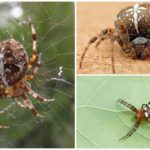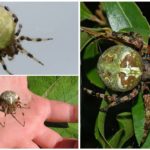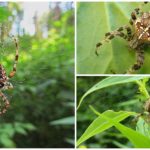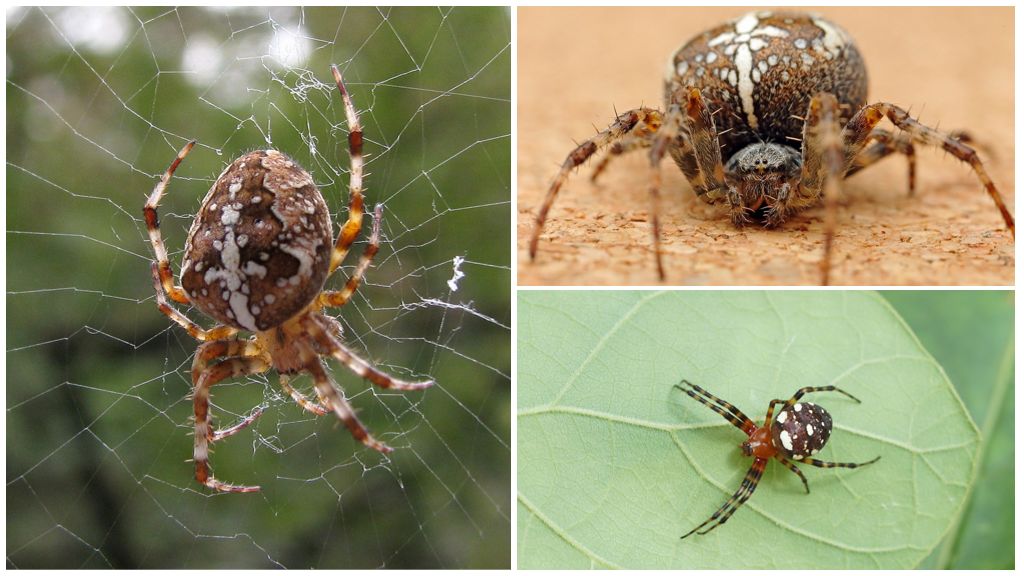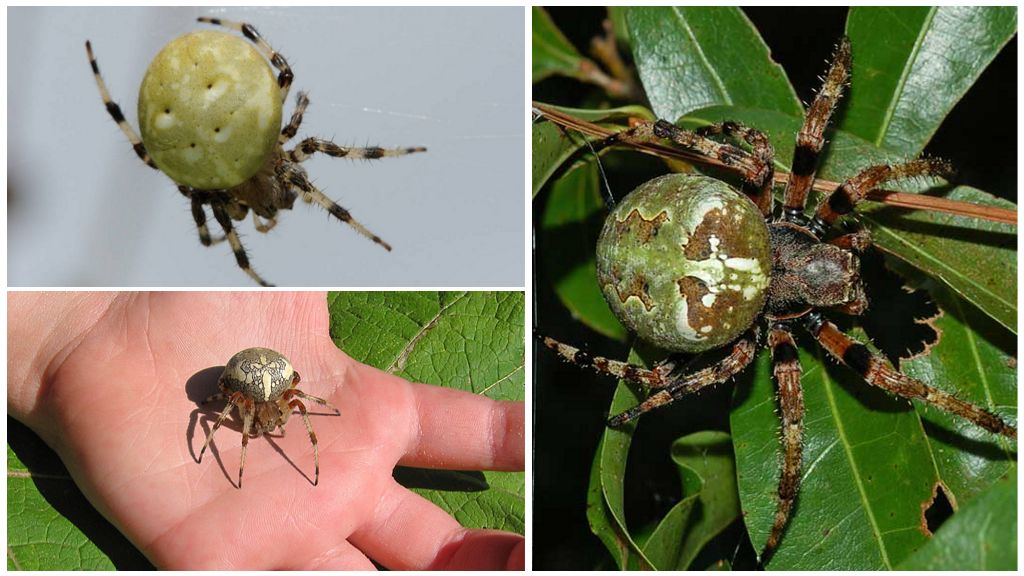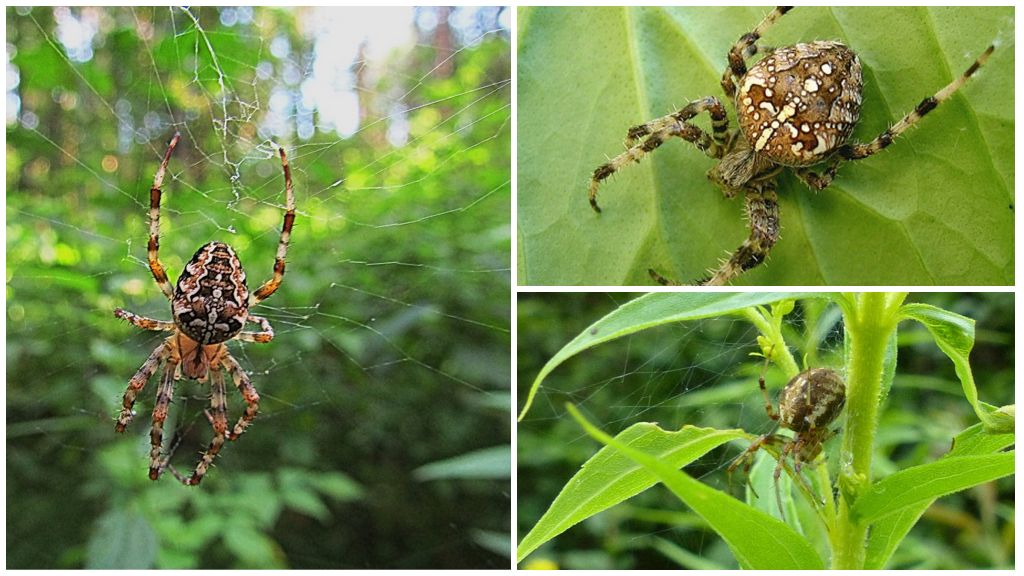Crusader Spider Description and Photos
Content
- Spider cross
- Types of spiders krestovikov
- Spider cross
Spider Crostovik, he is a crusader, araneus, belongs to the family of orbits - Araneidae. In the genus krestovikov there are 621 species. Spiders live all over the world, common in our area. You can meet a predator everywhere - in the forest, on the field, edge, park, garden, in the yard, outbuildings. Often creeps into the house through the cracks in the wall, open windows, doors.
Description and photo spider krestovik
The body size of females is from 20 to 40 mm, the male - 10 mm.Consists of a round convex abdomen, cephalothorax. The body is covered with durable shell, legs - villi. The extremities of the Crusader Spider 10, of which 4 pairs are walking legs. Front perform the function of claws - capture the victim, keep in the process of feeding. The paws are symmetrical to the size of the body. The structure does not differ from the typical representative of arachnids. The cephalothora connects with the abdomen with a thin web.
How many eyes a spider krestovik - 8. Placed on the front of the head. 6 in the center, 2 large sides. It provides a broad outlook, but does not provide a good view.
Interesting!
The spider is myopic, sees everything in general terms - movement, shadow, silhouette. The organs of smell and touch help to orient themselves in the space of the krestovik. Located on the legs. Caught in an unfamiliar place, the spider gently feels the space initially paws, and then moves.
What a crusader looks like depends on the species. The structure of the body is no different, but the color is different.
- The meadow krestovik lives in places with humid air, warm climate, dim light. Painted in brown, yellow, red tones.On the belly on the right side are white spots in the shape of a cross. Thanks to this identification mark, all species of araneus are called crosses. The meadow predator weaves a web on a grass, hunts on small insects.
- Forest krestovik differs from the garden, meadow darker color. The body is dark brown with white stripes. On the abdomen, a distinctive white or brown sign of the cross is clearly visible. Paws are long. The largest krestovik in Russia. The size together with the span of the legs reaches 4 cm.
- Far East krestovik differs large size. Habitat - forest, field, meadow. Color brown with different shades. The cross on the abdomen is white or yellowish. It weaves the largest web, which is 2 m in diameter. Even frogs, toads, snakes can get tangled in strong networks.
- An orange or yellow spider with a cross on its back is an ordinary crusader living in the shadowy places of the forest, field, meadow, garden. Araneus angulatus is a rare species listed in the Red Book. Body size about 18 mm.
- A predator with a red cross on its back is a type of meadow cross. Bright spots scare off enemies, but do not mean that this member of the genus is more poisonous.
- A black spider with a white cross on its back — a crusader who dwells near marshes, in a forest, in the fields, rarely approaches a man’s house. Externally resembles tegenaria.
What a cross looks like depends on the species, but distinguishes them from other representatives of arachnids with a characteristic pattern on the back in the shape of a cross. Hence the name.
Where dwells
The species is distributed throughout Europe, some species inhabit North America. Favorable living conditions are increased humidity, high temperature, and the absence of direct sunlight. The ideal habitat is coniferous forest, swamps, edges, hedges. Less likely to settle in the meadows, fields, gardens, gardens, household outbuildings, houses. In Russia, the CIS countries, there are about 30 types of crosses.
On a note!
Once in the house of the person, the spider chooses the place away from noise, light. Takes corners in the top of the room, below the furniture. Weaves a web. It feeds on "domestic" insects - flies, cockroaches. In order to get rid of a spider with a cross on its back, it is necessary to remove its web, throw it out into the street, poison the “living creature”.
Lifestyle
The common cross spider is a resident of the wild nature, but under certain circumstances it settles in the house. Leads nocturnal, daytime sitting still in a shelter or on the web of the web. He weaves it at night. Out of leaves he makes himself a shelter, between branches he builds a net of hunters.
Experts managed to find out how the female krestovik weaves. The network consists of 39 different radii that expand as they move away from the center, 35 spiral turns, 1245 points of contact of threads. The radius of the cobweb of a large Far Eastern cross reaches 2 m.
Interesting!
At night, the female weaves a net, during the day the victim is caught in it. The spider eliminates the damaged areas, forms new coils in its place. Birds are natural enemies, but at nightfall their activity decreases. Krestovik can work quietly.
The lifespan of a spider is theoretically 2 years. Under natural conditions, it is somewhat shorter. How much the spider the crosshair lives as a pet depends on the correct care. Lives safely to 2 years.
Nutrition
The main diet is insects of different sizes.Flies, wasps, hornets, grasshoppers, locusts, caterpillars, butterflies are caught in the trap of a spider web. In large durable cobwebs, snakes, frogs, toads, and mice are entangled.
The internal digestive system is absent, the liquefaction of food occurs outside. The spider bites the victim, injects poison, which paralyzes the muscles, immobilizes the prey. Krestovik launches saliva into the body of an insect, envelops it with cobwebs, waits a few minutes. For 5-20 minutes, the insides of the victim turn into a liquid mass, which the predator sucks.
Breeding
The mating season begins at the end of the summer. The female waits for the male on his web, feels his approach by the oscillation of the networks. After fertilization, it weaves a cocoon, lays up to 250 eggs inside. Carries with him, then leaves in a secluded place. In this state, the young overwinters. The light spiders are born in late April.
The period of maturation lasts several months. During this time, the nymphs molt about 5 times, increase in size, acquire a characteristic color. By the end of the summer become sexually mature. Caterpillars, aphids act as food for young stock.
On a note!
How adult spiders hibernate - hiding in the crevices of walls, utility rooms, forest floor, tree hollows. Show activity with increase in air temperature in the spring.
Poisonous or not crusader
The poison is toxic to invertebrates, vertebrates. It affects the organism of rats, mice, humans, rabbits. Sheep, horses, guinea pigs, dogs are resistant to the poison. For insects, invertebrates crusader attack is fatal. Animals appear a temporary deterioration of health, external irritation.
Crusader is not dangerous for humans. At the sight of people the spider tries to disappear imperceptibly. However, in the case of a threat to their own lives can bite. There are 2 small spots on the body. Initially, pain, burning. The next day, suppuration occurs. In people with weakened immunity, children feel worse. There is a weakness, nausea, headache, dizziness, abdominal discomfort. The condition is normalized after a few days.

